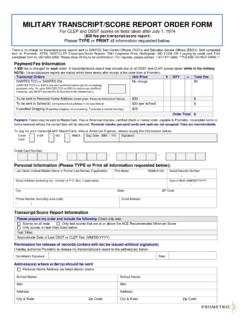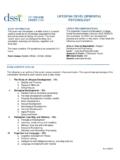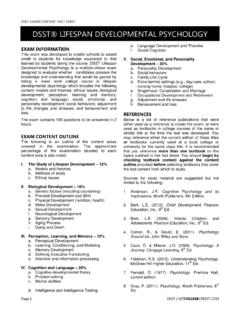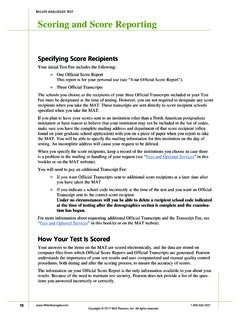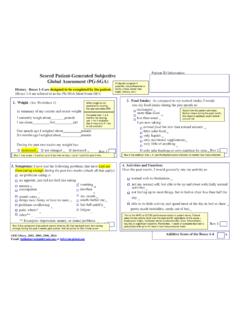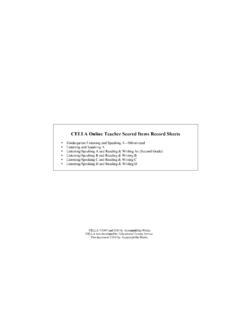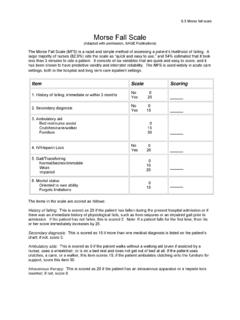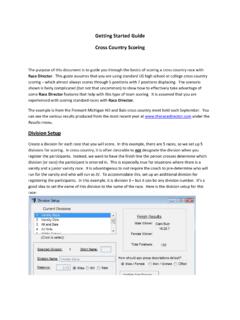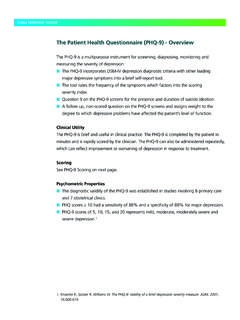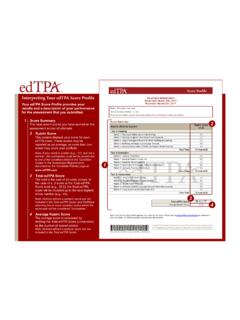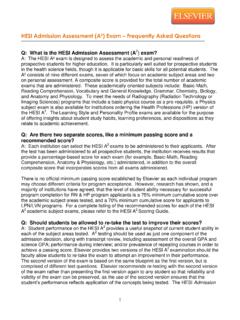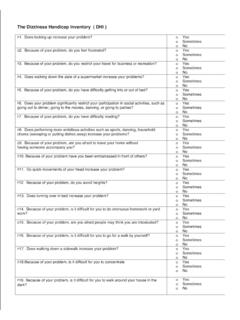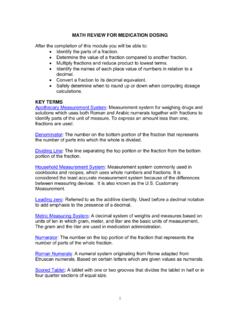Transcription of Exam Scoring 101 - Get College Credit
1 Exam Scoring 101 Exam Scoring 101 Having two Scoring methods simply means there are two ways of determining what a passing score should be. In 2008, Prometric began converting revised exams to the criterion-referenced method. By 2014, only 8 titles are still scored using the norm-referenced method. Both provide accurate, fair results to all test takers. SCENARIO A:Norm-Referenced Standard SettingMr. Jones teaches a math class with 30 students in it. On the upcoming exam, Mr. Jones decides that all students with scores in the top 75% will pass. Once the exam is given, Mr. Jones takes ALL the scores, compares them to each other and then accepts the highest 75% of scores as passing. In this case, it does not matter if Bill answered 85% of the questions correctly and Susie only answered 70% correctly because when looking at all the scores for all 30 students, both Bill and Susie got scores that fell among the top 75%.
2 Bill and Susie, as well as the other students who fell in the top 75% of scores, pass. The students in the class who scored in the lowest 25% will not pass, because as compared against the other students, they did not place in the top 75% (the cutoff set by Mr. Jones).DSST exams are scored using one of two Scoring methods: Norm-Referenced or Criterion-Referenced Standard Setting. The use of one or the other methodology depends on the DSST exam title and the date the exam was taken. One method is not better than the other they are just different ways of arriving at the same Standard SettingHistorically, DSST exams have been scored using a norm-referenced method to determine the pass/fail point for each exam. Using this method, a cut score is set based on judgments about groups of test takers; it establishes what proportions of each group should pass or fail.
3 Whether you pass or fail is based on how you perform in relation to others within the same group. DSST norm-referenced scores range from 20 to 80, with the passing score set between 44 and 49 (C-grade), depending on the exam Standard SettingThe Scoring model applied to all refreshed and new DSST exams is called criterion-referenced. This method sets cut scores based on judgments about individual test questions or the test as a whole. It determines how many of the test questions must be answered correctly in order to pass. Criterion-referenced scores are based on how much the test takers know, not how they performed against others in the same pool. Criterion-referenced scores range from 200 to 500, with the passing score set at 400 for all exams . SCENARIO B:Criterion-Referenced Standard SettingMr. Jones decides that each individual student taking his math test will need to answer 70% of the questions on the exam correctly to pass.
4 Since Bill gets 85% of the questions right, he passes because he answered more than 70% of the questions correctly (as pre-defined by Mr. Jones). Susie gets 65% of the questions right. Because she did not answer at least 70% of the questions correctly, she fails. Whether or not Bill or Susie passes is entirely dependent on whether they answered a certain percentage of questions correctly. It has nothing at all to do with how they performed on the exam in relation to each other or to the rest of the class or whether their score fell in the top 75% of all scores (as in scenario A).No. of StudentsFail PassGradePassing scores based on judgments and performance of group being tested. Passing scores based on judgments and performance of individual being tested. PassFailGradeNo. of StudentsThe American Council on Education's College Credit Recommendation Service (ACE Credit ) has evaluated and recommended College Credit for specific exams created and proctored through Prometric.
5 ACE Credit helps adults gain academic Credit for courses and examinations taken outside traditional degree programs. For more information, visit the ACE Credit website at 5/2017 Exam% Correct To PASSWhy does Prometric have two Scoring methodsfor DSST exams ?In the testing industry, there has been a movement toward using criterion-referenced methodologies, as it is a more widely accepted model. To keep up with today s testing environment, Prometric adopted this Scoring method for new and refreshed DSST exams . As we update exam titles, the updated exams are scored using the criterion-referenced was wrong with the previous way of Scoring ?Nothing is wrong with the previous way of Scoring , and Prometric continues to use norm-referenced standard-setting and a smaller score scale in all other non-refreshed DSST exams . However, across the testing industry there has been a general movement toward using criterion-referenced standard-setting, which is why DSST exams are being updated to that Scoring method.
6 Both standard-setting methods are accurate and is the Scoring scale 200-500?The best way to explain this is through an analogy. Temperature can be measured using either degrees Celsius or degrees Fahrenheit, which are different scales of measurement. The point at which water boils is the same, but it is expressed differently at 100 or 212 depending on which scale is used. The DSST scale works similarly; because different versions of each exam could require slightly different numbers of items to be answered correctly in order to pass, converting all scores to a common scale means the minimum passing score can remain exactly the same across all exams . The 200-500 scale is simply a way of relating one to the other to level the playing field. The numbers themselves are representative they were arbitrarily selected for the purpose of creating a students penalized for guessing wrong answers?
7 No, students are not penalized on any exam (refreshed or not) for wrong answers. Students are awarded points for correct answers. If a student answers incorrectly, they simply are not awarded the point for that all questions weighted evenly?Yes. All exam questions carry the same weight. Students areawarded points for correct answers, but they do not receive points for incorrect are essays scored on the exams that have them?Ethics in America and Technical Writing exams include optional essays and thus are not scored by DSST raters. The essays are forwarded to the institution the test taker designates, along with a score report. The essay is then scored by the Credit -accepting institution. Before taking either examination, students have to check with their College or university to determine whether the essay is 2017 Prometric. All rights reserved.
8 Prometric, DSST, and the DSST design logo are trademarks of Prometric. DSST Exam Scoring Frequently Asked QuestionsWhat does the di erence in Scoring methods mean? Scoring differences typically don t impact students. Students taking one of the refreshed DSST exams will need to answer a certain pre-defined percentage of the questions correctly in order to pass. The different versions of a given exam may vary in difficulty, but the number of test questions required to pass is adjusted to accommo-date any differences in difficulty for example, students receiving a more difficult version of a test title will be required to answer a lower percentage of questions correctly in order to pass. The percentage of test questions required to pass each exam falls within a range as follows (refreshed and new exams only):A History of the Vietnam WarArt of the Western WorldAstronomyBusiness Ethics and SocietyBusiness MathematicsComputing & Information TechnologyCriminal JusticeEnvironment and HumanityEthics in AmericaFoundations of EducationFundamentals of College AlgebraFundamentals of CounselingFundamentals of CybersecurityGeneral AnthropologyHealth & Human DevelopmentHistory of the Soviet UnionHuman Resources ManagementHuman Cultural GeographyIntroduction to BusinessIntroduction to Law EnforcementIntroduction to World ReligionsLifespan Developmental PsychologyManagement Information SystemsMath for Liberal ArtsMoney & BankingOrganizational BehaviorPersonal FinancePrinciples of Advanced English CompositionPrinciples of FinancePrinciples of Physical Science IPrinciples of Public SpeakingPrinciples of StatisticsPrinciples of SupervisionSubstance AbuseTechnical
9 WritingThe Civil War and Reconstruction58%59-68%49%57-58%45-46%61 -63%55-56%58-60%45-47%54-56%54%63-66%54- 58%54-55%58-59%42%57-59%62%49-51%58%46%5 3-55%52-55%65%51-53%62%51-52%
